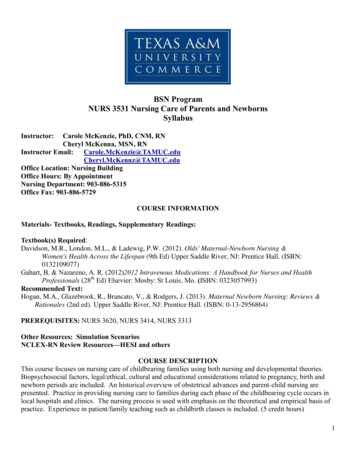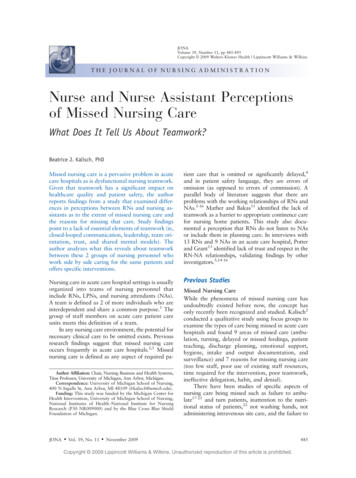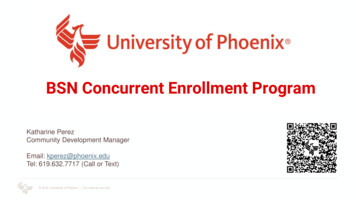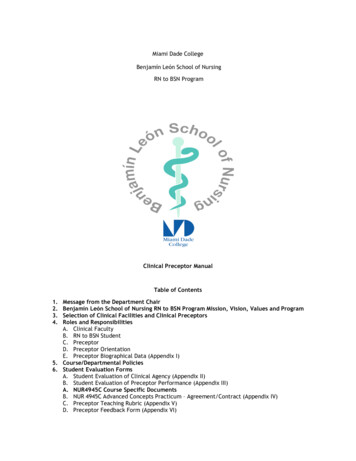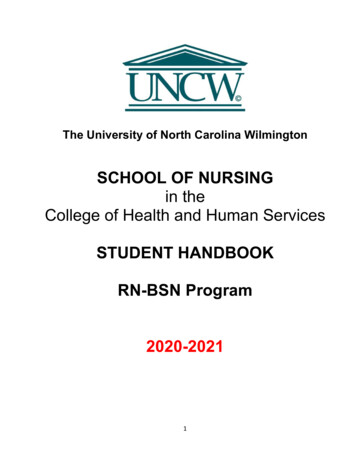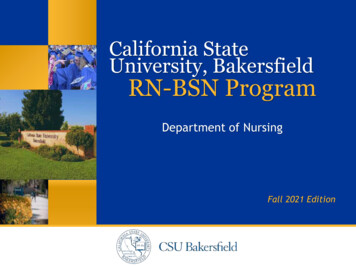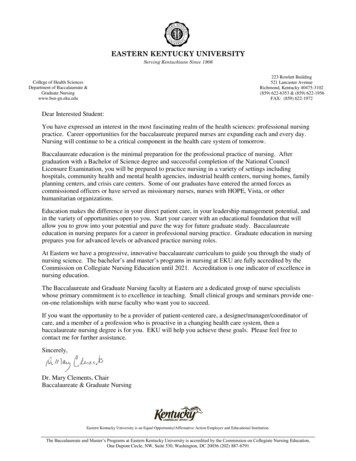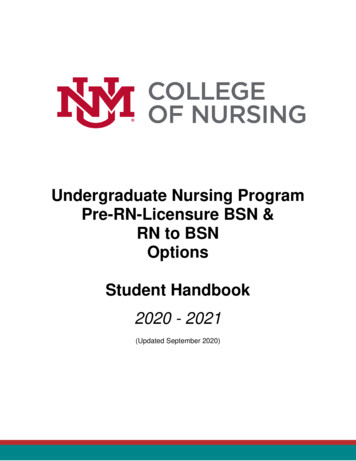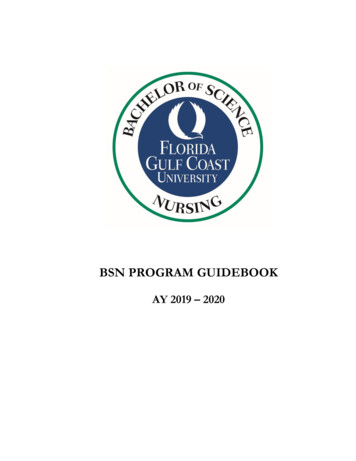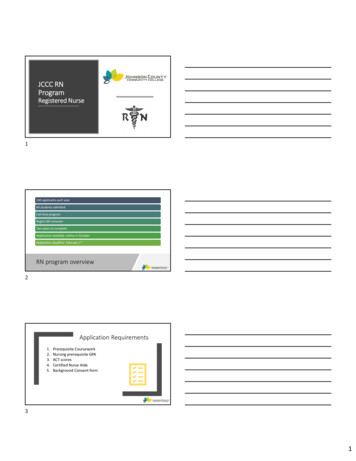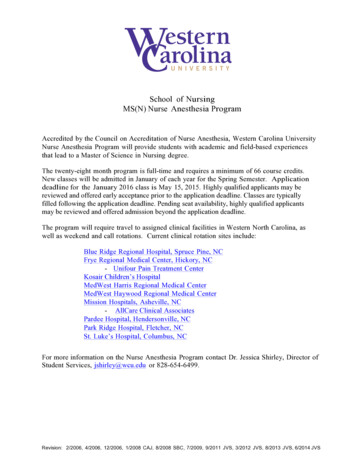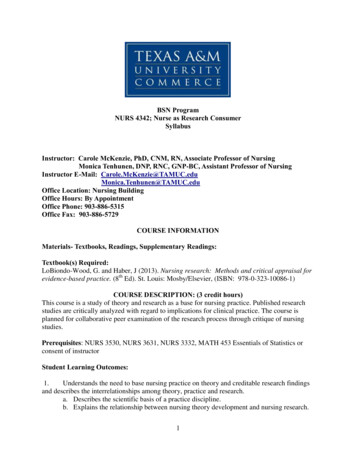
Transcription
BSN ProgramNURS 4342; Nurse as Research ConsumerSyllabusInstructor: Carole McKenzie, PhD, CNM, RN, Associate Professor of NursingMonica Tenhunen, DNP, RNC, GNP-BC, Assistant Professor of NursingInstructor E-Mail: Office Location: Nursing BuildingOffice Hours: By AppointmentOffice Phone: 903-886-5315Office Fax: 903-886-5729COURSE INFORMATIONMaterials- Textbooks, Readings, Supplementary Readings:Textbook(s) Required:LoBiondo-Wood, G. and Haber, J (2013). Nursing research: Methods and critical appraisal forevidence-based practice. (8th Ed). St. Louis: Mosby/Elsevier, (ISBN: 978-0-323-10086-1)COURSE DESCRIPTION: (3 credit hours)This course is a study of theory and research as a base for nursing practice. Published researchstudies are critically analyzed with regard to implications for clinical practice. The course isplanned for collaborative peer examination of the research process through critique of nursingstudies.Prerequisites: NURS 3530, NURS 3631, NURS 3332, MATH 453 Essentials of Statistics orconsent of instructorStudent Learning Outcomes:1.Understands the need to base nursing practice on theory and creditable research findingsand describes the interrelationships among theory, practice and research.a. Describes the scientific basis of a practice discipline.b. Explains the relationship between nursing theory development and nursing research.1
c. Identifies clinical nursing problems that need scientific investigation.d. States usual barriers to the use of theory and research findings to improve clinicalpractice.e. Analyze the ethical, legal, political, and economic dimensions of research studies andvarious ways of knowing.2.Demonstrates and analyzes the steps of the research process and models for applyingevidence to clinical practice.a. In selected research reports, identifies the steps of the research process.b. Identifies the decision points and options considered by the investigator as theresearch process is implemented.c. Distinguishes among different research designs and identifies the purposes, strengths,and weaknesses of each.d. Utilizes electronic communication to search data bases and disseminate findings.e. Analyzes basic characteristics of data collection methods.f. Evaluates data quality in quantitative and qualitative reports.3.Judges the value of selected nursing research studies and the protection of humansubjects by use of criteria.a. Describes selected research studies.b. Systematically critiques the research process in each study.c. Utilizes critical thinking to summarize the strengths and weaknesses of selectedstudy.d. Relates each study to its theoretical base and to clinical practice.e. Following a systematic critique states and defends a decision regarding utilization ofthe findings in clinical practice.f. Communicates research findings clearly, concisely, and in a cogent manner viawritten and verbal communication.g. Discuss the need to advocate for the protection of human subjects in the conduct ofresearch.4.Integrates selected adult principles and processes into the learning experience.a. Accepts responsibility for prior class preparation and active participation in each classmeeting.b. Evaluates own progress toward achievement of long term goals within the nursingprofession.c. Participates in the creation of a positive learning environment. Incorporates selectedelements of own practice throughout the learning experience.COURSE REQUIREMENTSInstructional / Methods / Activities AssessmentsThis course will be taught using any or all of the following methods: In‐class activities, writtenassignments, lecture, discussion, world‐wide‐web‐resources, web‐based discussions, emailinteractions, required readings, online quizzes/examinations, independent study, andlibrary/internet searches.2
GradingThe course grade will be determined by:Quantitative Research Article Critique (Individual)Qualitative Research Article Critique (Individual)PICOT questions (Individual)Retrieved Evidence Based Practice Literature (Individual)Evidence Based Practice Project and Presentation (Group)20%20%15%15%30%Grading ScaleA 90-100B 80-89C – 75-82D 67-74F 66 and belowResearch Critique Assignment (Individual) (20% each/40% total)You will select a quantitative and a qualitative nursing research article. Each study’s maincomponents should be summarized. A critique also contains comments about the positive andnegative aspects of the study and the report of the study. The critique should be written asconcisely as possible, no longer than five pages, typewritten, double-spaced. The paper shouldaddress all parts of the report equally, with strengths and weaknesses outlined where appropriate.Where possible, include suggestions for improvement. The Research Critiques must besubmitted electronically before the assigned due date and time. An electronic copy of theresearch discussed must be submitted with the assignment. At least one of the lead authors oneach article must be a nurse.Quantitative Critique due at 23:59 on Friday, March 28, 2014Qualitative Critique due at 23:59 on Friday, April 18, 2014See grading rubric below.PICOT questions (Individual) (15%)Five appropriately formatted PICOT questions will be submitted for review. One of them shouldbe for the evidence based research project. Be sure you write a question for each type of PICOTquestion and included all components of PICOT. An appropriate research article should beattached to each question.Assignment must be submitted electronically before the assigned due date and time.PICOT Questions due at 23:59 on Friday, January 31, 2014See grading rubric belowRetrieved Research Publications with APA Citations (Individual) (15%)The purpose of this assignment is to retrieve a minimum of 5 nursing research publications. Thegoal is to be able to differentiate research from other types of publications, with a focus onrecent, quantitative, nursing research. Copies of 5 retrieved full‐text publications are to besubmitted with an accurately cited reference page formatted in APA style. At least one of the3
lead authors on each article must be a nurse. Assignment must be submitted electronically beforethe assigned due date and time.Retrieved Evidence Based Practice Literature due at 23:59 on Friday, February 28, 2014See grading rubric below.Evidence Based Research Project and Presentation (30%) (Group Project)This project is to be done in a group to develop an evidence based research project, based on anapproved PICOT question. This question should be based on a patient situation and a proposednursing intervention. Utilizing the PICOT question, evaluate the evidence that supports theeffectiveness or lack of effectiveness of this intervention for this individual patient’s needs andpreferences. The hierarchy of evidence must be used to support the strength of evidence for yourintervention. Based on the evidence, a clinical decision must be made. Students will be assignedto a group at the beginning of the semester. Refer to grading rubric below. The project will bediscussed throughout the semester. Presentations will be at the end of the semester and will beevaluated according to the presentation grading rubric. In addition, each group member will beevaluated by other members of the group and members will have their individual grade for thepresentation adjusted accordingly.Evidence Based Research Project and Presentation due in class, 10a-12n on Thursday,April 24, 2014TECHNOLOGY REQUIREMENTSThis course will be enhanced using eCollege, the Learning Management System used by TexasA&M University-Commerce. To login to the course, go to: http://leo.tamuc.edu/login.aspx.You will need your CWID and password to log in to the course. If you do not know your CWIDor have forgotten your password, contact Technology Services at 903.468.6000 orhelpdesk@tamuc.eduThe following hardware and software are necessary to use eCollege.-Internet access/connection-high speed recommended (not dial up)-Word Processor (MS Word, or Word Perfect)Our campus is optimized to work in a Microsoft Windows environment. This means our courseswork best if you are using a Windows operating system (XP, Vista, or 7) and a recent version ofMicrosoft Internet Explorer (6.0, 7.0, 8.0, or 9.0).Your courses will also work with Macintosh OS X or better along with a recent version of Safari(5.1 is now available). Along with Internet Explorer and Safari, eCollege also supports theFirefox browser (3.0) on both Windows, and Mac operating systems.It is strongly recommended that you perform a “Browser Test” prior to the start of your course.To launch a browser test, login to eCollege, click on the “myCourses” tab, and then select the“Browser Test” link under Support Services.4
COMMUNICATION AND SUPPORTCommunication between faculty and students is important and taken seriously. Preferredcommunication methods are through individualized faculty office hours, email, or office phone.If a phone call is not answered, please leave a message and send an e-mail using the direct e-maillink on the course home page. You will be treated with collegial respect and you are expected tocommunicate likewise in a professional manner.COURSE AND UNIVERSITY PROCEDURES/POLICIESCLASS1.Class Cancellation: In the event that a class is canceled, the student is expected to do thereadings and complete the objectives for that day. The content will still be included onexaminations. The material in this syllabus and dates identified in the Course Calendarare subject to change.2.Class attendance is expected. The students should notify course faculty in advance of anyabsence.3.Exam dates are listed in each course syllabus, and the student is expected to be presentfor exams. In the event that the student will be absent, the course instructor must benotified in advance. Failure to do so will result in the student receiving a zero for themissed exam or quiz.4.As an adult learner and responsible professional, the student is responsible for readingand completing assignments prior to class and for being prepared to participate indiscussions over the assigned material. It should not be expected that all material will becovered in class. Students are expected to come to class prepared.5.Assignments must be handed in on time. Assignments submitted late without priorarrangement with the classroom instructor will receive a zero.ADA StatementThe Americans with Disability Act (ADA) is a federal anti-discrimination statute that providescomprehensive civil rights protection for persons with disabilities. Among other things, thislegislation requires that all students with disabilities be guaranteed a learning environment thatprovides for reasonable accommodation of their disabilities. If you have a disability requiring anaccommodation, please contact:Office of Student Disability Resources and ServicesTexas A&M University-CommerceGee Library 132Phone (903) 468-8148Fax (903) uStudent Disability Resources & Services5
Student Conduct Code – Refer to the BSN Student GuideStudents must adhere to standards of professional and academic conduct. Academic misconductinvolves any activity that tends to compromise the academic integrity of the University, orsubvert the educational process, including, but not limited to, cheating, plagiarism, falsifyingacademic records, misrepresenting facts and any act designed to give unfair academic advantageto the student or the attempt to commit such an act. Students are responsible for their ownacademic honesty and for reporting violations of academic honesty by others.6
WeekDates11/2021/27COURSE CALENDARReadingAssignmentsLoBiondoWood and HaberIntroduction to Course;Chapter 1What is Nursing ResearchEvidence Based Practice andits EnvironmentTheoretical and ConceptualChapter 4FrameworksContentClass 1/21 1-3pDrs. McKenzie and Tenhunen1/31PICOT Questions Due32/3The Research ProcessChapters 2 3Research Problems, Questionsand HypothesesLiterature Review42/10Systematic ReviewsChapter 1152/1762/24Reliability and Validity;RigorTypes of ResearchSampling PlansChapter 1573/383/1793/24Quantitative ResearchDesignsEvaluating QuantitativeResearchData Collection,Measurement, and QualityChapters 8 9 10103/31114/7Ethics in ResearchChapter 13Qualitative ResearchQualitative AnalysisTrustworthiness and Integrityin Qualitative ResearchData AnalysisChapters 5 6 7Class 4/10 1-3pDr. McKenzieChapter 16Using results in PracticeChapters 19 20 214/18 Qualitative ResearchCritique DueClass 4/24 10-12 noonEBP ProjectPresentations/Paper Due124/14134/21Chapter 12Class 2/6 1-3pDr. TenhunenClass 2/20 1-3pDr. McKenzie2/28 Retrieved Evidence BasedPractice LiteratureClass 3/6 1-3pDr. TenhunenChapters 17 18Chapter 147Class 3/27 1-3pDr. Tenhunen3/28 Quantitative ResearchCritique Due
QUANTITATIVE RESEARCH CRITIQUE GUIDEUse the following guide in writing the critique:1. Statement of the Problem/Purpose Is the problem/purpose clearly stated? Is it easy to identify and locate? Is it significant to nursing?2. Review of Literature Is it recent? Five years or newer? Were primary sources of authorities or experts used? Is it relevant to the stated problem? Does it provide a solid basis for the study?3. Conceptual/Theoretical Framework Is there a theoretical or conceptual framework, rationale, and/or map, and (if so) is itappropriate? If not, is the absence of one justified? Are key concepts adequately defined conceptually?4. Hypothesis(es) or research question(s) Are research questions and/or hypotheses explicitly stated? If not, is their absencejustified? Are they adequately stated with clear specification of key variables and the studypopulation? Are they placed in the contexts of a theoretical or conceptual framework?5. Research Method(s) Were appropriate procedures used to safeguard the rights of study participants? Was thestudy subject to external review by an IRB/ethics review board? Was study designed to minimize risk?6. Research Design Does the approach fit the purpose and hypothesis (es)? Was the most rigorous possible design used, given the purpose of the research? Was the number of data collection points appropriate? Did the design minimize biases and threats to internal construct, and external validity ofthe study?7. Population and Sample Was the population properly identified and described? Was the sample described insufficient detail? Was the best possible sampling design used to enhance the sample’s representativeness?Were sample biases minimized? Was the sample size adequate? Was a power analysis used to estimate sample size needs?8
8. Data Collection and Measurement Are the operational and conceptual definitions congruent? Were key variables operationalized using the best possible method and with adequatejustification? Are instruments objective? Reliable? Valid? Were data collected in a manner that minimized bias? Were the staff that collected dataappropriately trained?9. Data Analysis Were appropriate statistical methods used, given the level of measurement of thevariables, number of groups being compared? Is a thorough descriptive analysis given? Were Type 1 and Type II errors avoided or minimized?10. Presentation of Findings/Implications Are all hypotheses discussed with findings adequately summarized, with appropriate useof tables and figures? Are findings reported in a manner that facilitates a meta-analysis and with sufficientinformation needed for evidence based practice? Were the recommendations for clinical practice and further research reasonable andcomplete? Are limitations presented and adequate?9
QUALITIATIVE RESEARCH CRITIQUE GUIDE1.Is the research tradition for the qualitative study identified? If none was identified, canone be inferred? If more than one was identified, is this justifiable or does it suggest“method slurring”?2. Does the study purpose match the study design? Was the best possible design (orresearch tradition) used to address the study purpose? Is the research question congruentwith a qualitative approach and with the specific research tradition?3. Is the design appropriate, given the research question? Does the design lend itself to athrough, in-depth, intensive examination of the phenomenon of interest?4. Does the report describe an explicit theoretical or conceptual framework for the study? Ifnot, does the absence of a framework detract from the significance of the research or itsconceptual integration?5. Given the nature of the data, was the data analysis approach appropriate for the researchdesign?6. Is the category scheme described? If so, does the scheme appear logical and complete?Does there seem to be unnecessary overlap or redundancy in the categories? Weremanual methods used to index and organize the data, or was a computer program used?7. Did the report adequately describe the process by which the actual analysis waspreformed? Did the report indicate whose approach to data analysis was used (e.g.,Glaserian or Straussian, in grounded theory studies)?8. What major themes or processes emerged? If excerpts from the data are provided, do thethemes appear to capture the meaning of the narratives?9. What evidence did the report provide that the analysis is accurate and replicable? Weredata displayed in a manner that allows you to verify the researcher’s conclusions?10. Did the analysis yield a meaningful and insightful picture of the phenomenon understudy? Did the report give you a clear picture of the social or emotional world of studyparticipants?11. Which specific techniques (if any) did the researcher use to enhance the trustworthinessand integrity of the inquiry? Where these strategies used judiciously and to good effect?Given the efforts to enhance data quality, what can you conclude about the study’svalidity/integrity/rigor/trustworthiness? Does the report adequately address thetransferability of the findings?10
12. Did the report discuss any study limitations and their possible effects on the credibility ofthe results or on interpretations of the data? Were results interpreted in light of findingsfrom other studies? Did the researchers discuss the study’s implications for clinicalpractice or future research?11
RESEARCH CRITIQUE ASSIGNMENT GRADING CRITERIAName: Date:Critique ofareas/coveragerelevant to the topic ofthe paperOrganization of thepaper, manner ofpresentationWording and phrasing0Inadequate,many importantthings missing5Adequate, somegaps (7 Areas)10Good (10 alproblems10Acceptable, butnot outstanding15Excellent,ideas flownicely0Poor wording/phrasing5Frequentlyambiguous orvague10Frequentlyawkward, butclear15Excellent,ideas flownicelyUse of proper citationsand referencingmethods within bodyof the paper0Improper use ofAPA referencestandardsUse of proper formatfor reference list andor bibliography0No referencelist Not APAformatGrammar and sentencestructure0Poor5Missing quotation marks, page #’smissing, poor paraphrasing5Numerous errors or mistakes5Adequate10Good15Excellentcoverage(all 13 areas)10Properlycited andreferenced10Follows APAformatEarned Points15ExcellentPunctuation, spelling,unedited typing,neatness0More than 10errors55-9 errorsOn Time-25More than 2weeks late-152 weeksMaximum Points 10010Few errors15Excellent-51 week late0On TimeTotal:12
RETRIEVED RESEARCH PUBLICATIONS GRADING CRITERIA1.Submission of 5 Nursing Research Publicationsa. Published articles are RESEARCHb. Articles are from a quality peer‐reviewed nursing journalc. At least one of the lead authors of each article is a nursed. Minimum of 2 studies that were published in the past 5 yearse. Maximum of 1 qualitative study permittedf. No meta‐analyses or comprehensive reviews are permittedg. Copy of full article is required, not just abstracth. Group members are NOT permitted to duplicate articles80%
Instructor: Carole McKenzie, PhD, CNM, RN, Associate Professor of Nursing Monica Tenhunen, DNP, RNC, GNP-BC, Assistant Professor of Nursing Instructor E-Mail: Carole.McKenzie@TAMUC.edu Monica.Tenhunen@TAMUC.edu Office Location: Nursing Building Office Hours: By Appointment Office Phone:
